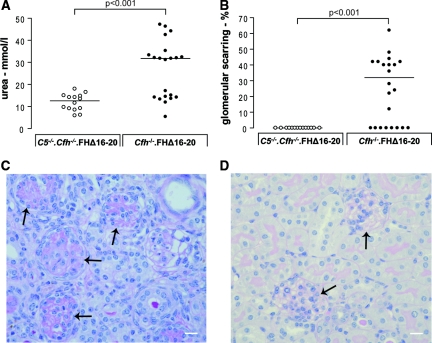Figure 1.
C5−/−.Cfh−/−.FHΔ16–20 mice do not develop spontaneous aHUS. (A) Assessment of renal function. Because of the accelerated mortality and morbidity urea, levels could only be assessed in 21 of the 26 Cfh−/−.FHΔ16–20 mice. In these animals the median urea level was 31.8 mmol/L (range = 5.4 to 47.2, n = 21, P < 0.001 versus C5−/−.Cfh−/−.FHΔ16–20 mice). Using 20 mmol/L as the upper limit of normal, 57% of the Cfh−/−.FHΔ16–20 mice were uraemic at the time of analysis. In contrast, serum urea levels in C5−/−.Cfh−/−.FHΔ16–20 mice were all <20mmol/L (median = 12.6 mmol/L, range = 5.9 to 18, n = 14). (B) Assessment of renal pathology. The glomerular histologic appearances in all of the C5−/−.Cfh−/−.FHΔ16–20 mice were normal at 4 months (n = 14). In contrast, evidence of renal thrombotic microangiopathy was evident in the majority of Cfh−/−.FHΔ16–20 mice by 4 months. Of the 22 renal specimens available for analysis, glomerular scarring was evident in 14 mice by 4 months of age. The horizontal bars denote median values. (C and D) Renal histology. (C) Example of glomerular scarring seen in Cfh−/−.FHΔ16–20 mice. (D) In contrast the glomeruli in C5−/−.Cfh−/−.FHΔ16–20 mice were normal. Glomeruli are indicated by arrows. Original magnification, 20. Bar, 10 μm.

